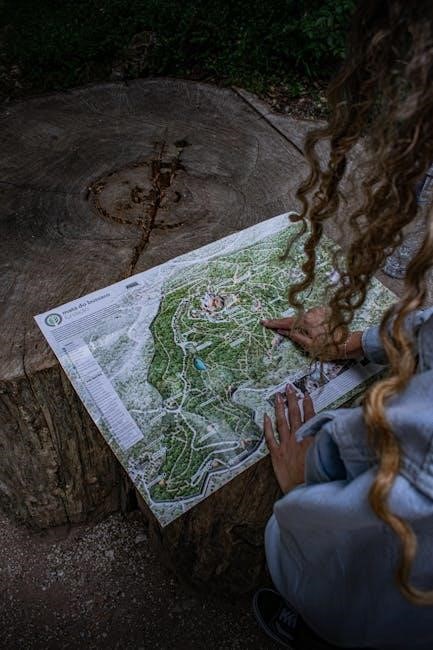Roller skating is a vibrant activity that combines fitness, fun, and creativity. Properly fitting skates are essential for comfort, performance, and safety, ensuring a seamless skating experience.
Why Proper Sizing Matters for Comfort and Performance
Proper sizing is crucial for both comfort and performance in roller skating. Ill-fitting skates can lead to discomfort, blisters, and even affect your ability to skate effectively. Skates that are too tight may cause pain and restrict movement, while those that are too loose can lead to poor control and stability. A well-fitting pair ensures optimal support and maneuverability, enhancing your overall skating experience; Accurate sizing also prevents discomfort and allows for better performance, making it essential to choose the right fit for your feet.
Understanding Shoe Size vs. Roller Skate Size
Shoe and roller skate sizing differ due to design and fit requirements. Skate sizes often vary by brand, and proper fit is crucial for performance and comfort.
Key Differences Between Shoe and Skate Sizing
Roller skate sizing often differs from shoe sizing due to variations in boot design, materials, and intended use; While shoes are measured for standing comfort, skates prioritize performance and support during movement. Many brands recommend sizing down 1-1.5 sizes from shoe size for a snug fit, but this can vary. Additionally, skate styles like quads and inlines have distinct sizing standards, and some brands may run truer to shoe sizes than others. Accurate foot measurement is crucial to ensure the best fit for skating.
Why You Shouldn’t Assume Your Shoe Size Will Match Your Skate Size
Assuming your shoe size matches your skate size can lead to discomfort and performance issues. Skate sizing varies by brand and style, with most requiring a 1-1.5 size reduction. Factors like boot material, cushioning, and intended use influence fit, making it essential to measure feet accurately and consult specific brand size charts. Different skating styles, such as derby or speed, may also require adjustments. Always verify sizing guidelines for your chosen brand and skate type to ensure optimal comfort and performance.
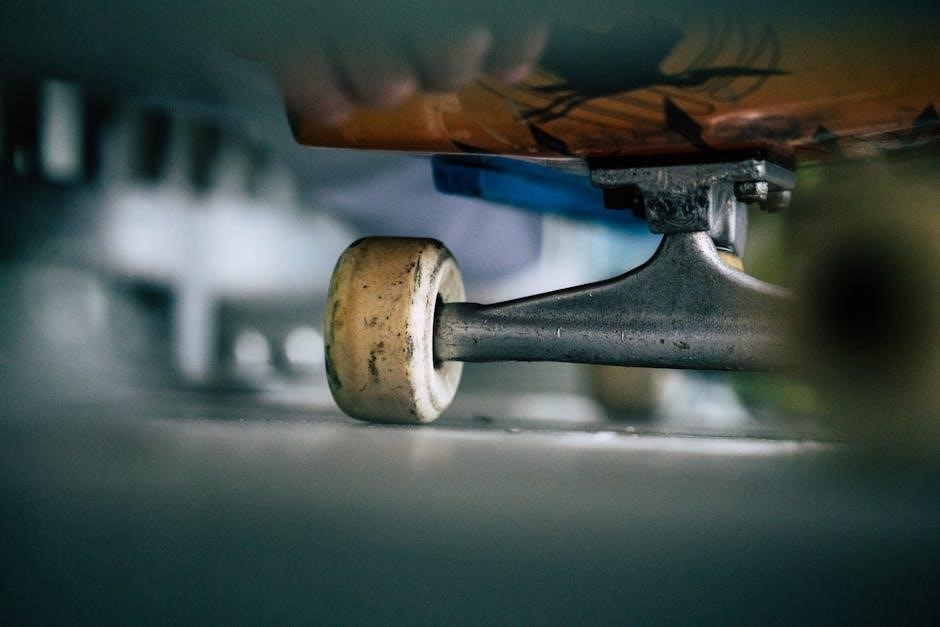
How to Measure Your Feet Accurately
Measure your feet by standing on paper, tracing the outline, and using a ruler or Brannock device. Ensure accurate results by measuring at the end of the day when feet are largest.
Step-by-Step Guide to Measuring Foot Length and Width
To accurately measure your foot length, place a ruler on the ground and stand barefoot, aligning your heel with the ruler’s edge. Measure from the back of the heel to the tip of the longest toe. For width, wrap a flexible measuring tape around the widest part of your foot, just above the arch. Record both measurements to determine your ideal skate size, ensuring a comfortable and precise fit for optimal performance.
When to Measure Your Feet for the Best Fit
Measure your feet at the end of the day when they are at their largest due to natural swelling. This ensures the most accurate fit, as feet tend to expand throughout the day. Avoid measuring in the morning or after extended periods of rest, as this may result in a smaller measurement. Proper timing helps prevent discomfort, blisters, or poor performance due to an ill-fitting skate. Consistency in measurement timing is key to achieving the best fit for your roller skates.
How to Choose the Right Roller Skate Size
Choosing the right roller skate size involves more than just measurements; consider brand size variations, personal comfort, and skating style for optimal performance.
Understanding the 1 to 1.5 Size Down Rule
The 1 to 1.5 size down rule is a common guideline for roller skate sizing, meaning skates are typically smaller than shoe sizes. This difference arises because skates have sturdier constructions and require a snug fit for control and performance. However, this rule isn’t universal and can vary by brand and foot shape. Always check the brand’s size chart and consider personal comfort. Some skaters find they need even more size adjustment for optimal fit, so it’s crucial to try them on or refer to detailed guides before purchasing.
Factors to Consider Beyond Foot Measurement
Beyond foot length and width, consider your skating style, boot type, and personal comfort preferences. Skaters with wider or narrower feet may need specific brands or models. Boot materials, such as leather or synthetic, also impact fit and flexibility. Additionally, sock thickness and whether you prefer a snug or roomier feel can influence sizing. Some skaters opt for a slightly looser fit for comfort during long sessions, while others prioritize tightness for performance. These factors ensure a tailored fit beyond basic measurements.
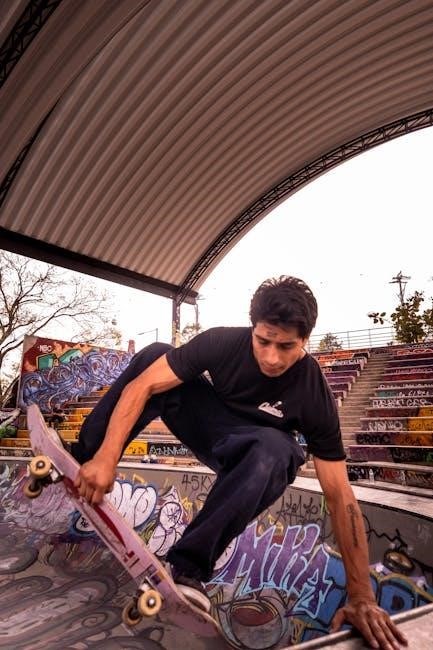
Different Roller Skate Styles and Their Sizing
Quad, inline, and specialized skates vary in sizing. Quad skates often fit tighter, while inline skates may align closer to shoe size. Always check brand-specific charts.
Quad Roller Skates vs. Inline Skates: Sizing Differences
Quad roller skates and inline skates differ in sizing due to their design. Quad skates often fit tighter, aligning with shoe size minus 1-1.5 sizes, while inline skates may match shoe size more closely. This variation stems from their intended use: quads prioritize stability and maneuverability, while inlines focus on speed and agility. Always consult brand-specific charts, as sizing can vary significantly between styles and manufacturers. Proper fit is crucial for performance and comfort in both types.
Specialized Skates: Derby, Speed, and Recreational
Specialized roller skates like derby, speed, and recreational styles have unique sizing needs. Derby skates often fit snugly for stability, while speed skates may require a tighter fit for precision. Recreational skates tend to align closely with shoe size for comfort. Brand-specific size charts are essential, as sizing can vary. Proper fit ensures optimal performance, whether for high-energy derby matches, speed competitions, or casual skating sessions.
Brands and Their Sizing Variations
Brands like Riedell, Rollerblade, and Bont offer unique sizing charts. Some brands run true to shoe size, while others require adjustments. Always check brand-specific guides for accuracy.
Major Brands and Their Size Charts
Major brands such as Riedell and Bont provide detailed size charts to help skaters find their perfect fit. Riedell, for instance, offers specific sizing guides for different skate models, ensuring accuracy. Bont skates often require a size slightly smaller than shoe size. Rollerblade skates typically fit true to US sizes, making them a reliable choice for many. Always refer to the brand’s official size chart to ensure the best fit for optimal comfort and performance.
Why Some Brands Run Truer to Shoe Size Than Others
Some brands align closely with shoe sizes due to consistent manufacturing standards and precise sizing templates. Rollerblade skates, for example, are known to fit true to US shoe sizes, making them easier for skaters to choose without additional adjustments. Other brands like Riedell and Bont may vary slightly, as their sizing can differ based on specific skate models or materials. This variance emphasizes the importance of consulting brand-specific size charts for an accurate fit.
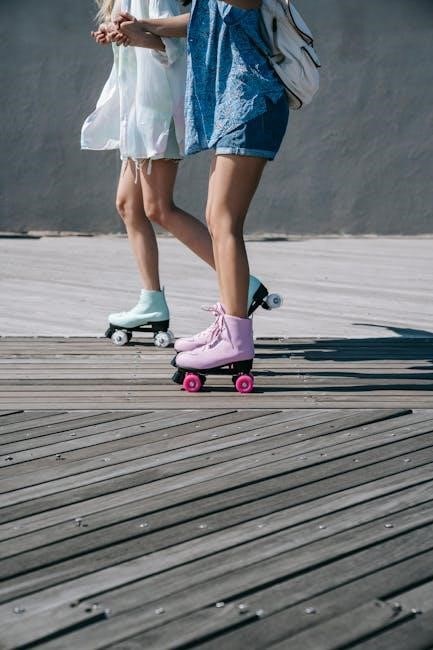
Tips for Ensuring a Perfect Fit
Measure your feet accurately, try skates during afternoon, and refer to brand-specific size charts for optimal fit and skating comfort.
Trying Skates On: What to Look For
When trying on roller skates, ensure a snug fit without discomfort. Check for adequate toe room, a secure heel, and proper support. Skates should feel comfortable and allow for slight movement. Pay attention to the width and how the boot hugs your foot. Avoid overly tight skates, as they can cause pressure points. Walk around to assess balance and mobility. A well-fitting skate will enhance performance and reduce the risk of blisters or discomfort during skating sessions.
Breaking In Skates: How to Avoid Discomfort
Breaking in roller skates requires patience to ensure comfort and prevent blisters. Start with short skating sessions, gradually increasing duration. Wear thin, moisture-wicking socks to reduce friction. Use a heat gun or hair dryer to soften stiff areas, then wear skates to mold them to your feet. Avoid tight lacing initially, ensuring a snug but not restrictive fit. Properly broken-in skates will provide long-lasting comfort and enhance your skating performance.
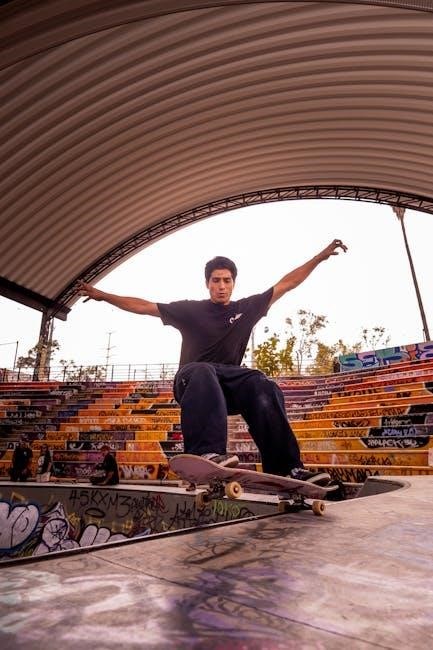
Roller Skate Size Charts
Roller skate size charts provide conversion guides for men, women, and kids, ensuring accurate fit. They include length and width measurements, helping to match foot size to skate size precisely.
Men’s Size Chart: Conversion and Fit Guide
Men’s roller skate size charts typically align with U.S. shoe sizes but may require a 1 to 1.5 size reduction for optimal fit. For example, a size 9 shoe often corresponds to a size 8 skate. Brands like Riedell and Rollerblade offer detailed charts to ensure accuracy. Measure both foot length and width, as wider feet may need a larger size. If unsure, consult brand-specific guides or visit a specialty store for a precise fit to avoid discomfort and performance issues.
Women’s Size Chart: Conversion and Fit Guide
Women’s roller skate sizing often aligns closely with standard shoe sizes but may require adjustments. For instance, a women’s shoe size 8 typically translates to a skate size 7 or 7.5. Always refer to the brand’s specific size chart, as some skates are designed with a narrower or wider fit. Measure your foot length and width to ensure accuracy. If you’re a half size, consider sizing up for comfort. Proper fit ensures optimal performance and comfort during skating sessions.
Kids’ Size Chart: Growth and Adjustment Tips
Kids’ roller skate sizing must account for growth and comfort. Adjustable skates are ideal, as they grow with the child’s foot. Measure their feet regularly, as sizes can change quickly. Choose skates with adjustable lacing or straps for a secure fit. Consider the thickness of socks worn while skating and ensure there’s enough room for toes to wiggle. Refer to the brand’s size chart for accurate conversions. Opt for a snug but not tight fit to accommodate growth while maintaining support and performance.
Half Sizes and Width Considerations
For half sizes, consider rounding up or down based on brand fit. Some skates offer adjustable features to accommodate growth or width variations, ensuring comfort and support. Brands like Moxi and Riedell often provide size charts that address half sizes and width options, helping you find the perfect fit for narrow or wide feet. Always check the brand’s specific sizing guide for accurate measurements and adjustments.
What to Do If You’re a Half Size
If you’re a half size, consider rounding up or down based on the brand’s fit. Some skates accommodate half sizes with adjustable features. Check the brand’s size chart, as some offer half-size options. If unsure, try on skates or use insoles for a snug fit. Brands like Moxi and Riedell provide detailed guides to help you choose the right size. Contact customer support for personalized advice to ensure the best fit for your skating experience.
Narrow vs. Wide Feet: How to Choose the Right Skate
For narrow feet, opt for skates with a snug fit to avoid excessive movement, which can cause discomfort. Wide feet benefit from roomier boots or adjustable models. Measure your foot width accurately and consider brands offering multiple widths, like Riedell. Trying skates on ensures the best fit. Leather boots often mold to your feet over time, improving comfort. Proper fit enhances performance and reduces the risk of blisters or discomfort, making it crucial to choose skates tailored to your foot shape for an optimal skating experience.

Boot Type and Fit
Boot type significantly impacts skating performance. Low-cut boots offer agility, while high-cut boots provide stability. Choose materials like leather for durability or synthetic for easier break-in, ensuring a snug fit for optimal comfort and control.
Low-Cut vs. High-Cut Boots: Which is Right for You?
Low-cut boots prioritize agility and flexibility, ideal for tricks and dance skating, while high-cut boots provide enhanced stability and support, perfect for roller derby and speed skating. Choosing the right style depends on your skating style and personal comfort preferences. Proper fit ensures optimal performance and prevents discomfort during sessions.
Boot Materials and Their Impact on Fit
Boot materials significantly influence comfort, durability, and overall skating performance. Leather boots are breathable and durable, offering a snug fit, while synthetic materials provide affordability and ease of maintenance. Heat-moldable boots adapt to foot shapes for a customized fit, ideal for skaters with unique foot structures. The choice of material affects support, flexibility, and weight distribution, ensuring a balance between comfort and performance. Proper material selection ensures a comfortable and responsive skating experience, tailored to individual needs and skating styles.
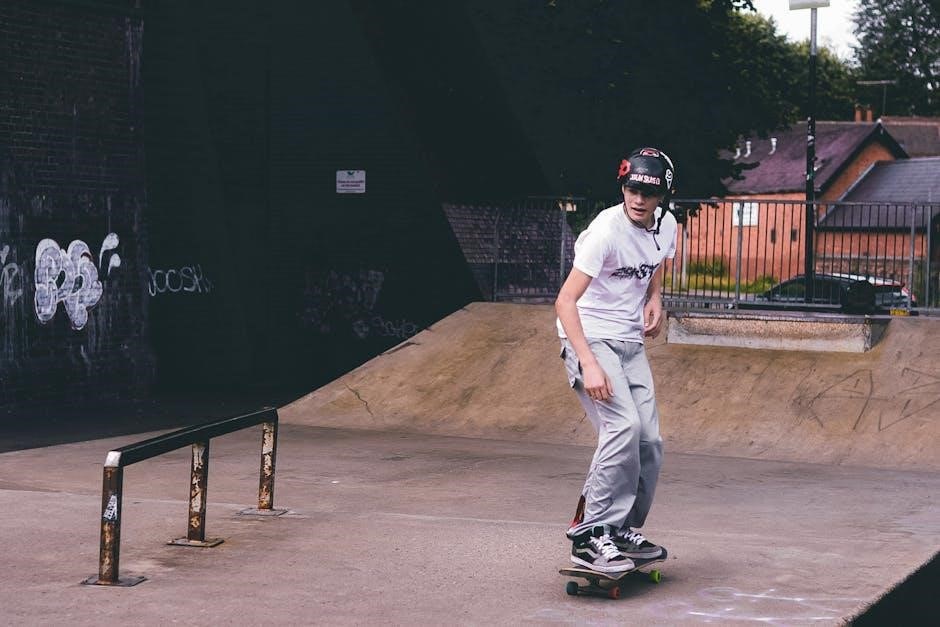
Wheel Size and Its Impact on Performance
Wheel size significantly affects speed, stability, and maneuverability. Larger wheels enhance speed and glide, while smaller wheels improve agility and control, catering to different skating styles and surfaces.
How Wheel Size Affects Speed and Maneuverability
Wheel size plays a crucial role in determining speed and agility. Larger wheels (65mm+) roll faster, maintain momentum, and glide smoothly, making them ideal for speed skating and long-distance rolls. Smaller wheels (57-59mm) offer quicker acceleration, tighter turns, and better control, perfect for tricks, dance skating, or navigating tight spaces. The right size ensures optimal performance, balancing speed and maneuverability based on skating style, terrain, and personal preference.
Choosing the Right Wheel Size for Your Skating Style
Understanding your skating style is key to selecting the right wheel size. For speed and endurance, opt for larger wheels (65mm+), which roll efficiently and maintain momentum. Smaller wheels (57-59mm) are ideal for agility, tricks, and dance skating, offering quick acceleration and sharp turns. Outdoor skating often benefits from mid-sized wheels (62mm) for stability on uneven surfaces. Match your wheel size to your primary activity to ensure optimal performance, comfort, and enjoyment, balancing speed and maneuverability based on your skating goals.

The Importance of Proper Fit for Performance
A well-fitting roller skate ensures optimal control, stability, and performance while reducing fatigue. Poor fit can lead to discomfort and hinder your skating experience significantly.
How Ill-Fitting Skates Can Affect Your Skating
Ill-fitting roller skates can cause discomfort, hinder performance, and lead to fatigue. Tight skates restrict movement, causing blisters or pain, while loose skates reduce control and stability. Poor fit can also result in inefficient skating, as energy is wasted due to improper support. Over time, this can discourage skaters and limit their progress. Proper sizing is crucial to ensure a smooth, enjoyable experience on the rink or pavement. Always prioritize a well-fitting pair for optimal comfort and performance.
Benefits of a Well-Fitting Pair of Skates
A well-fitting pair of roller skates enhances comfort, performance, and overall skating enjoyment. Properly sized skates reduce fatigue, provide better control, and improve maneuverability. They also minimize discomfort, such as blisters or pain, allowing skaters to focus on technique and speed. A good fit ensures optimal support, which is essential for stability and confidence, especially during sharp turns or quick stops. Investing in the right size guarantees a more enjoyable and productive skating experience for skaters of all levels.
Common Mistakes to Avoid When Choosing a Size
Assuming your shoe size matches your skate size and not measuring your feet accurately are common errors. Always consult brand-specific size charts to ensure the best fit and avoid discomfort.
Mistakes That Can Lead to Poor Fit and Discomfort
Assuming your shoe size directly translates to skate size is a common mistake, as skates often run smaller. Not measuring both length and width can also lead to poor fit. Ignoring brand-specific size charts and failing to consider personal comfort preferences are additional errors. These oversights can result in discomfort, blisters, and reduced performance. Always measure accurately and refer to the manufacturer’s guidelines to ensure a proper fit.
How to Avoid Sizing Errors
To avoid sizing errors, measure your feet accurately and consult the brand-specific size charts. Try skates on with the same thickness of socks you plan to wear. Ensure there’s minimal toe movement and no heel slippage. Consider both length and width for a snug, comfortable fit. Don’t assume your shoe size translates directly to skate size, as sizing varies by brand. If possible, visit a store for a fitting or order from brands with flexible return policies. Proper fit ensures optimal performance and comfort.
Adjusting to Your New Skate Size
Allow a breaking-in period for your skates to mold to your feet. If discomfort persists, consider a different size for optimal comfort and performance.
Breaking In Period: What to Expect
The breaking-in period typically lasts a few weeks, during which skates may feel snug or stiff. Gradual wear helps mold the boot to your foot shape, enhancing comfort. Minor discomfort is normal, but persistent pain signals a poor fit. Wear them for short sessions initially, then extend as they soften. Proper care and patience ensure a comfortable, customized fit for enjoyable skating sessions.
When to Consider a Different Size
If your skates cause persistent pain, numbness, or restricted movement, it may be a sign that the size is incorrect. Skates that are too tight can hinder performance, while those too loose may lead to blisters or instability. If the breaking-in period doesn’t resolve discomfort, consult the size chart or seek advice from a professional fitter. Proper fit is crucial for both safety and enjoyment, so don’t hesitate to adjust if necessary.
Final Tips for Buying the Perfect Pair
Measure your feet accurately, refer to brand-specific size charts, and try skates on if possible. Proper fit ensures comfort and performance, making your skating experience enjoyable and safe.
Accurate foot measurement is crucial for proper fit. Use brand-specific size charts, as sizing varies. Consider the 1 to 1.5 size down rule from shoe size. Ensure snugness without discomfort for optimal performance. Boot type and width also impact fit. Try skates on if possible and break them in gradually. Proper sizing enhances comfort, control, and overall skating enjoyment. Refer to reliable guides and brand resources for the best results. Prioritize fit to avoid discomfort and improve your skating experience.
Where to Find Reliable Sizing Information
Consult brand-specific size charts on manufacturer websites for accurate fit guidance. Many brands, like Riedell and Rollerblade, offer detailed sizing tools. Visit skate shops or online forums for real-user feedback. Use size comparison databases to cross-reference shoe and skate sizes. Measure your feet precisely and consider factors like boot type and width. Reliable sizing information ensures a perfect fit, enhancing your skating experience. Always refer to trusted sources to avoid sizing errors and discomfort.



